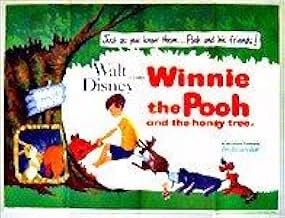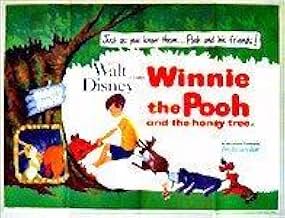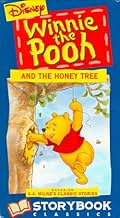Christopher Robin's bear attempts to raid a beehive in a tall tree.Christopher Robin's bear attempts to raid a beehive in a tall tree.Christopher Robin's bear attempts to raid a beehive in a tall tree.
- Awards
- 1 nomination total
Junius Matthews
- Rabbit
- (voice)
Ralph Wright
- Eeyore
- (voice)
Barbara Luddy
- Kanga
- (voice)
Howard Morris
- Gopher
- (voice)
Clint Howard
- Roo
- (voice)
Sebastian Cabot
- Narrator
- (voice)
James MacDonald
- Bees
- (voice)
- (uncredited)
Dal McKennon
- Bees
- (voice)
- (uncredited)
Thurl Ravenscroft
- Bass Vocals
- (voice)
- (uncredited)
Ginny Tyler
- Bees
- (voice)
- (uncredited)
Featured reviews
'Winnie the Pooh and the Honey Tree (1966)' was the first animated adaptation of A.A. Milne's children stories, and presents itself rather charmingly as a moving picture-book depicting the imaginary adventures of Christopher Robin and his favourite toys. In this first episode, directed by Wolfgang Reitherman (future director of 'The Aristocats (1970)'), Winnie the Pooh (voiced by Sterling Holloyway) attempts rather unsuccessfully to steal honey from a bee-hive in the uppermost branches of a tree, before getting himself stuck in the front-door burrow of an increasingly-exasperated Rabbit.
The film seems to have been rather influential in the Soviet Union. The first Russian Winnie the Pooh cartoon, released as 'Vinni-Pukh (1969)', uses the same storyline. 'The Fox and the Hare (1974),' from my favourite animator Yuri Norstein, similarly uses the stylistic device of animating its characters as figures in a moving storybook. Here, I was slightly disappointed by the absence of Piglet. He appears for a moment in here, but doesn't say anything. John Fiedler, who subsequently voiced the character in 'Winnie the Pooh and the Blustery Day (1968),' would continue to do so until his death in 2005, and his voice is quite unmistakable.
The film seems to have been rather influential in the Soviet Union. The first Russian Winnie the Pooh cartoon, released as 'Vinni-Pukh (1969)', uses the same storyline. 'The Fox and the Hare (1974),' from my favourite animator Yuri Norstein, similarly uses the stylistic device of animating its characters as figures in a moving storybook. Here, I was slightly disappointed by the absence of Piglet. He appears for a moment in here, but doesn't say anything. John Fiedler, who subsequently voiced the character in 'Winnie the Pooh and the Blustery Day (1968),' would continue to do so until his death in 2005, and his voice is quite unmistakable.
If memory serves, the original Steiff toy belonging to the late Christopher Robin Milne, "Winnie the Pooh", now resides in Manhattan, either at the New York Public Library or at publisher E.P. Dutton's headquarters. The symbolism is obvious: a British children's classic has made the transatlantic leap.
Disney scriptwriters have been heavily criticized for de-emphasizing the Britishness of Pooh, beginning with this first film in what became a series of theatrical short subjects. Most of the voices - Christopher is an exception - are American. Sterling Holloway became so identified with the title role that it is hard to imagine anyone else, British or American, taking it over.
The best thing about "Winnie the Pooh and the Honey Tree" is that it is adapted directly from Alan Milne's printed work. As I did in 1966, a child today seeing this film for the first time could ask for the book version and receive something unusually congruent with the screenplay.
Christopher Robin Milne, bookshop owner and authors' rights heir, had notoriously mixed feelings about his father's creation. In particular, he had his doubts about the effect Disney's version might have on the original.
Not to worry: the Disney machine has generated far more positive attention for Pooh than a global army of publishers.
Disney scriptwriters have been heavily criticized for de-emphasizing the Britishness of Pooh, beginning with this first film in what became a series of theatrical short subjects. Most of the voices - Christopher is an exception - are American. Sterling Holloway became so identified with the title role that it is hard to imagine anyone else, British or American, taking it over.
The best thing about "Winnie the Pooh and the Honey Tree" is that it is adapted directly from Alan Milne's printed work. As I did in 1966, a child today seeing this film for the first time could ask for the book version and receive something unusually congruent with the screenplay.
Christopher Robin Milne, bookshop owner and authors' rights heir, had notoriously mixed feelings about his father's creation. In particular, he had his doubts about the effect Disney's version might have on the original.
Not to worry: the Disney machine has generated far more positive attention for Pooh than a global army of publishers.
1966 was the year when the first animated short of Winnie the Pooh and his friends came out. These characters immediately became a phenomenon of popularity and they're still just as popular nowadays. It all started with "Winnie the Pooh and the Honey Tree" in 1966, followed by many other Winnie the Pooh's shorts, all of them taking place in the magical and childish world of the Hundred Acre Wood.
This first adventure introduces us these adorable characters, as well as Winnie the Pooh, the little bear obsessed by hunny (honey), lovingly called «silly old bear» by Cristopher Robin. However, Piglet and Tigger's first appearance is only in the following short "Winnie the Pooh and the Blustery Day". Anyway, we can see right from the start how the characters's personalities are.
A delightful story, lovely songs (such as "Little Black Rain Cloud", "Up, Down and Touch the Ground", "Rumbly in My Tumbly" and "Winnie the Pooh"), great artwork and animation, charm and classic humor are another attribute here.
The story is amusing and focus mostly on Pooh's determination to get some honey. Although he is a bear with very little brain, he's not the sort of bear to give up easily. It's funny how he often thinks of something, but no matter how hard he tries to think, the only thing that comes to his simple mind is honey. And it's funny that he does physical exercises, but not for the reasons you could think. You think he does physical exercises to get thinner? You better think again, he he he! He does physical exercises to get hungry, as an excuse to eat honey.
The Gopher (who is not in the book) is hilarious, especially whenever he falls down his hole. That is spectacular! The nervous Rabbit can be unfair at times, but he does the right thing when he stops the Gopher from feeding Pooh with honey.
As for Eeyore, his pessimistic personality is obvious right from the beginning, when he says «If it's a good day, which I doubt».
This first adventure introduces us these adorable characters, as well as Winnie the Pooh, the little bear obsessed by hunny (honey), lovingly called «silly old bear» by Cristopher Robin. However, Piglet and Tigger's first appearance is only in the following short "Winnie the Pooh and the Blustery Day". Anyway, we can see right from the start how the characters's personalities are.
A delightful story, lovely songs (such as "Little Black Rain Cloud", "Up, Down and Touch the Ground", "Rumbly in My Tumbly" and "Winnie the Pooh"), great artwork and animation, charm and classic humor are another attribute here.
The story is amusing and focus mostly on Pooh's determination to get some honey. Although he is a bear with very little brain, he's not the sort of bear to give up easily. It's funny how he often thinks of something, but no matter how hard he tries to think, the only thing that comes to his simple mind is honey. And it's funny that he does physical exercises, but not for the reasons you could think. You think he does physical exercises to get thinner? You better think again, he he he! He does physical exercises to get hungry, as an excuse to eat honey.
The Gopher (who is not in the book) is hilarious, especially whenever he falls down his hole. That is spectacular! The nervous Rabbit can be unfair at times, but he does the right thing when he stops the Gopher from feeding Pooh with honey.
As for Eeyore, his pessimistic personality is obvious right from the beginning, when he says «If it's a good day, which I doubt».
Wonderful classic tells the story of Winnie the Pooh's honey craving and the lengths he will go to in order to get some. It's a fun story with the memorable image of Pooh stuck in the door to Rabbit's house that everybody is familiar with. The characters, as always, are lovable and memorable. In addition to Pooh and Rabbit, there's Kanga, Eeyore, Owl, Roo, Gopher, and, of course, Christopher Robin. Piglet and Tigger would appear in the next Pooh short from Disney. The animation is excellent and there's some great songs by the Sherman Brothers. Let's not forget Sebastian Cabot's terrific narration. It's a great cartoon and would appear later in "The Many Adventures of Winnie the Pooh," which is where I first saw it.
This is a wonderful gem, with great memorable songs by the Sherman Brothers, and excellent animation.
The story is great fun, with Pooh running out of honey and climbing up a tree to get it. Afterwards, he gets stuck in the door of Rabbit's house and has to wait until he's thin enough to budge.
The characters were wonderful, especially Gophyr, I particularly loved the phrase, "that supercilious scoundrel has confiscated my honey". They are well voiced by the likes of Sterling Holloway, John Fiedler and Junius Matthews, with Sebastian Cabot giving a thoughtful insight as the narrator.
This vignette is wonderful, highly recommended! 10/10 Bethany Cox
The story is great fun, with Pooh running out of honey and climbing up a tree to get it. Afterwards, he gets stuck in the door of Rabbit's house and has to wait until he's thin enough to budge.
The characters were wonderful, especially Gophyr, I particularly loved the phrase, "that supercilious scoundrel has confiscated my honey". They are well voiced by the likes of Sterling Holloway, John Fiedler and Junius Matthews, with Sebastian Cabot giving a thoughtful insight as the narrator.
This vignette is wonderful, highly recommended! 10/10 Bethany Cox
Did you know
- TriviaGopher often says, "I'm not in the book." This has a double meaning: he's not in the phone book and he is also not in the A.A. Milne book. Gopher is the only Disney's Pooh character that did not originate in Milne's books. He was originally created to replace Piglet, until they decided to bring Piglet in for Winnie the Pooh and the Blustery Day (1968).
- GoofsAfter Pooh gets stuck in Rabbit's door, Rabbit sits in a chair and hums, but the hum is in Pooh's voice.
- Quotes
Narrator: Winnie the Pooh crawled out of the gorse bush, brushed the prickles from his nose, and began to think again.
Winnie the Pooh: Think, think, think.
Narrator: And the first person he thought of was...
Winnie the Pooh: Winnie the Pooh?
Narrator: [chuckles] No, Christopher Robin.
Winnie the Pooh: Oh.
- Crazy creditsA live action Winnie The Pooh teddy bear winks at the audience at the very end of the film.
- Alternate versionsWhen released in The Many Adventures of Winnie the Pooh (1977), Bruce Reitherman, who voiced Christopher Robin, was replaced by a different actor. Furthermore, the closing scene of this short (mainly the animation of the book pages) was altered so as to segue into the next scene rather than bring the short to an end, as is the case with the original short.
- ConnectionsEdited into The Many Adventures of Winnie the Pooh (1977)
- SoundtracksWinnie the Pooh
Music and Lyrics by Richard M. Sherman and Robert B. Sherman
Performed by The Disney Chorus
Details
- Release date
- Country of origin
- Language
- Also known as
- Winnie the Pooh and the Honey Tree 3D
- Filming locations
- Production companies
- See more company credits at IMDbPro
- Runtime25 minutes
- Aspect ratio
- 1.37 : 1
Contribute to this page
Suggest an edit or add missing content






























